#indian weavers
Text
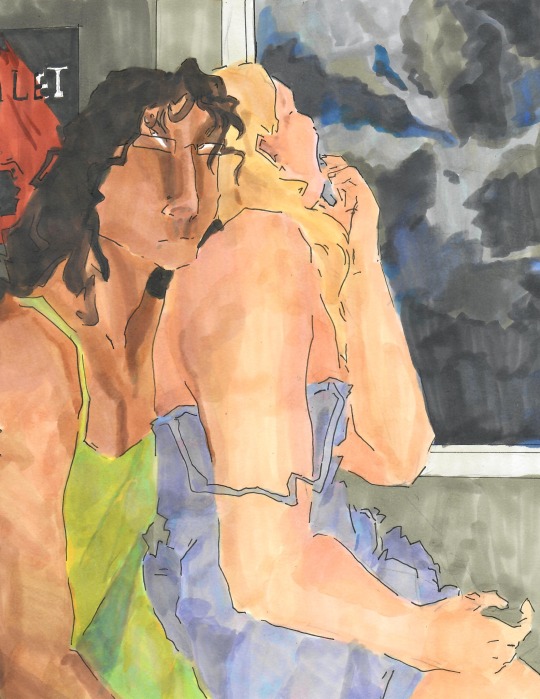
IMAGE ID: A copic marker illustration of Taylor Hebert, a light brown skinned Jewish girl with dark brown curly hair and glasses wearing a lime green dress with spaghetti straps, sitting next to Lisa Wilbourn, a blonde white girl wearing a pale purple dress, similar to Taylor’s. Taylor rests her head on Lisa’s shoulder, looking towards the camera with a suspicious expression, while Lisa looks out a window at a stormy sky. She has one hand up, gesturing by her face, and the other resting on her thigh. They sit inside a room with gray walls. Behind Taylor’s head is a red-brown, black, and white poster for the play Hamlet. END ID.
I didn’t mean for Taylor to look kinda Indian in this, but it happened. Anyway, these two still live rent free in my head even after all these years.
#worm#parahumans#taylor hebert#ward#wildbow#Lisa wilbourn#skitter#weaver#tattletale#Sarah livsey#my art#illustration#fanart#art#copic markers#artists on tumblr#aesthetic#grunge#Taylor ended up looking kind of Indian in this huh#smugbug#Taylor/Lisa#Taylor Hebert/Lisa Wilbourn#fan art#fandom
36 notes
·
View notes
Text
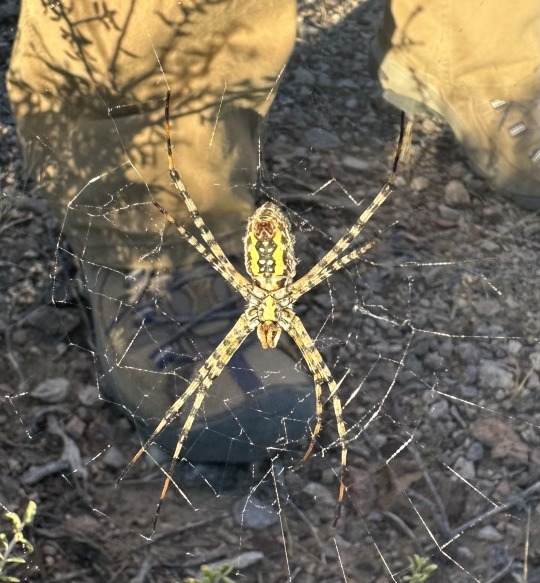



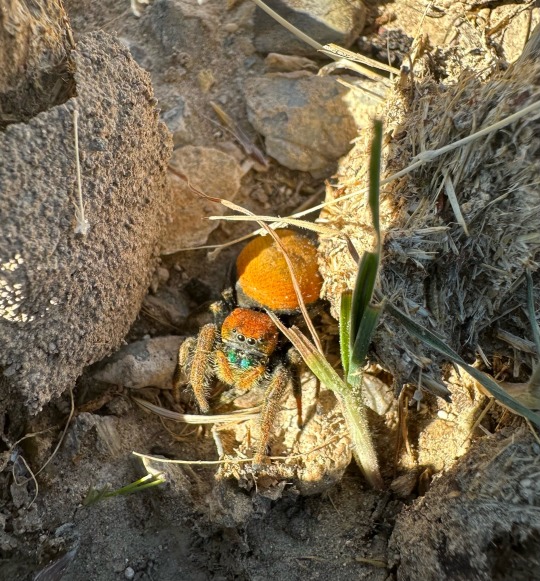
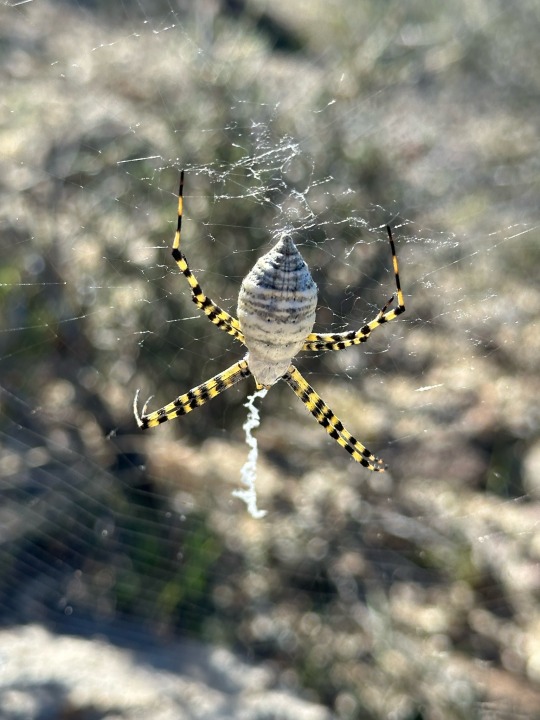



#nevada#desert#wildlife#nature photography#nature#southwest#tarantula#indian paintbrush#mojave desert#Mojave indigo#orb weaver
1 note
·
View note
Text


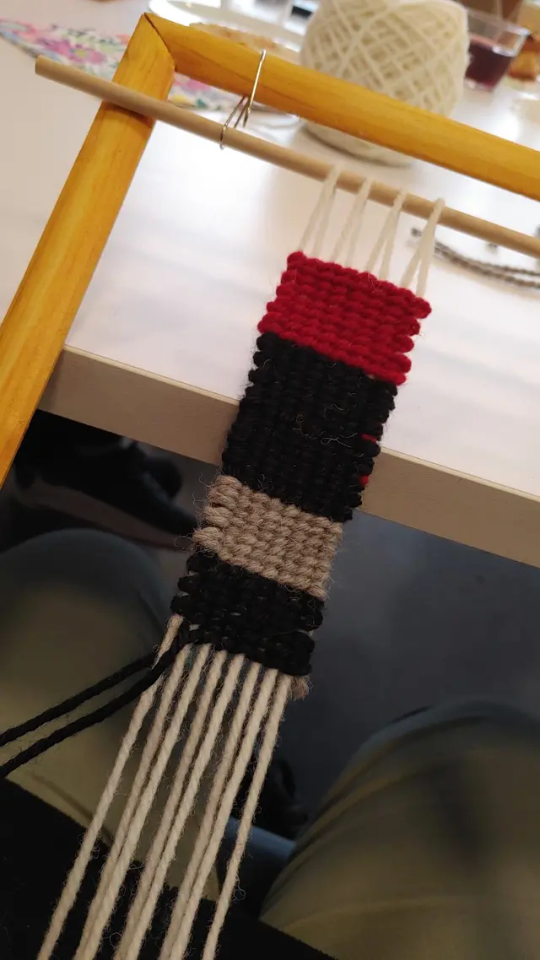
Learning to weave and she's looking a little funky but that's fine, she's unique. Definitely harder than I thought it would be but luckily I can find all my materials from the dollar store so I can practice at home✨
#indigenous#firstnations#Aboriginal#native#indian#metis#materials practice#weaving#weaver#art#artist
1 note
·
View note
Text
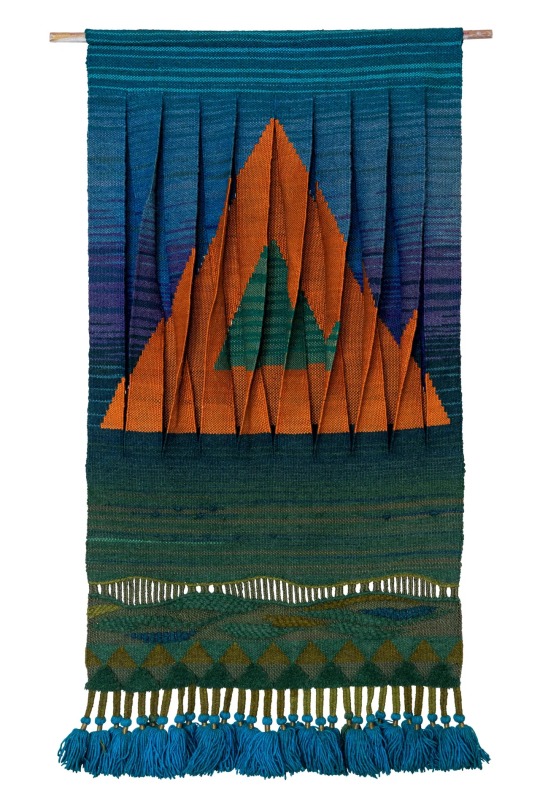
Nelly Sethna
Untitled
(1980-1990)
(Collection of Gayatri and Priyam Jhaveri)
#nelly sethna#textiles#textile artist#textile design#textile artists#indian artists#indian textiles#sethna#weaver#indian crafts#indian arts#art of india#scandinavian design#wall hanging#tapestry#tapestries
1 note
·
View note
Text
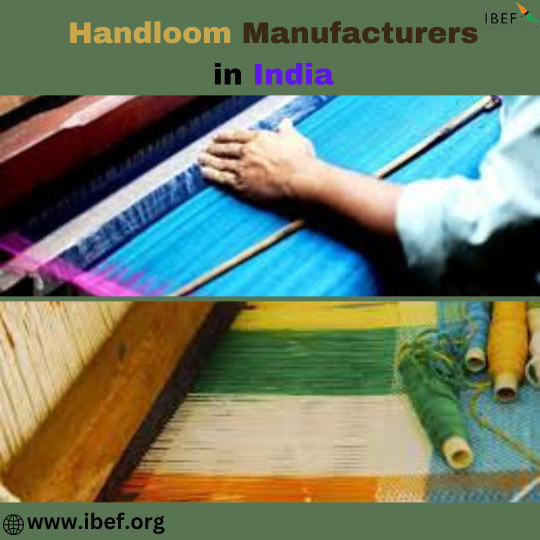
Handloom Manufacturers in India - IBEF
Handloom products are a testament to India's rich cultural heritage and skilled craftsmanship. Handloom manufacturers in India use traditional techniques to create unique textiles, ranging from sarees and stoles to home furnishings and accessories. These products are eco-friendly, and sustainable, and promote fair trade practices. The handloom industry provides livelihoods to millions of skilled weavers across India, and their artistry has been passed down through generations. By supporting handloom manufacturers, consumers can preserve India's cultural heritage and promote ethical and sustainable fashion.
#handloom clothes#handloom products#handloom weavers in india#indian handloom#handloom manufacturers in India#handloom export promotion
1 note
·
View note
Note
Hi! You don't have to answer this if you don't want to, that's totally fine! But you talking about Orville Peck's appropriation of indigenous culture with his fashion choices made me realize that I had never considered that there might be some aspects of "cowboy clothes" that white ppl shouldn't wear and that was super wrong of me. Again, you totally don't have to answer this, but I was just wondering what ways a white person could wear "cowboy clothes" in a manner that wasn't disrespectful? Or perhaps, should we not wear them at all? I can't afford T yet, but when I can finally get it I was planning on getting a cowboy outfit to embrace my trans mascness, but if that would be wrong of me I can scrap that plan no problem!
Ehhh again this is actually SUPER HARD to answer because almost everything about cowboy fashion & the cowboy "aesthetics" are lifted directly from Native American fashion and culture, either because a lot of cowboys back in the day were Native American themselves (including Afro-Natives & Indigenous Mexican vaqueros) or they were White & just kinda. stole the look from the Native cowboys due to a number of factors.
If you google "cowboy jewelry" the first thing that comes up is silverwork & belts & turquoise jewelry, which is taken from Navajo metalwork. Fringed leather clothing? Again, many Native tribes did that (& in some tribes the fringes could mean something, its not just for looks), most popularily with vests, jackets, and pants. A lot if the leather jackets were a result of Native women just sewing their clothes the same but in a European styled cut. Compare this "cowboy" look below to a Lakota war shirt: both have hair embellishments dangling from the arms.


Studded belts? Inspired by Cheyenne mirror belts, which often also have metal studs in them & you'll still see Native pow wow dancers have this in their regalia. Floral vests? A lot of the inspiration comes from Plains floral beadwork. Geometric patterns and blankets? Came from Southwest or Mexican Native American blankets & designs, ask any Navajo weaver & they'll tell you the same. Feathers in cowboy hats? Who else is famous for wearing feathers on their heads--? Native Americans. The look is still popular with older Native men.
Hell, if you visit this site that sells Western/cowboy fashion, you'll see a SHITTON of appropriation going on, taking Native imagery & designs, including one taken from Native American ledger art, all on White models.

The appropriation of Native culture and fashion in the cowboy/western sphere is ongoing, and the influence that Native fashion & culture has in Western/cowboy fashion as it is is absolutely MASSIVE. I once said in another post that the cowboy/western aesthetic essentially belongs to Native Americans, Latines (especially Mexicans), and Black people. And the history of White cowboys has been one largely of colonialism, racism, and displacement of Indigenous peoples, and the masculinity associated with White cowboys especially is also steeped into racism & American patriotism (think John Wayne. There's a reason he's an American icon who played cowboys & killing Indians in films.). I think the only thing that isn't influenced from either appropriation or colonization is like, jeans. Even the style of cowboy boots themselves and potentially chaps were influenced from vaqueros.
So if you're White I'm not sure that'd exactly be a good route to take because trying to seperate Indigenous elements from this fashion/look (nevermind the problematic history of White cowboys) is almost impossible. Obviously I can't force you to do anything, but honestly if I were you, I'd try a different direction, because otherwise I think you'll find trying to do this will be very hard.
174 notes
·
View notes
Text
The way how some people are just not aware of what the British Monarchy did in the name of 'trade' and 'civilization'..... Genuinely asking, what the hell is going on in your history classes?
When I was 10 years old, I learnt about the Mughals invasion, how the British set foot into India to trade spices and then established British India in the name of 'civilization'.
When I was 11 years old, I heard about the divide and conquer strategy, the livelihood of workers in plantations, how various handloom and weavers went out of work and starved to death.
When I was 12, I learnt about the Nizams cruel rule over my birthplace, Bhagath Singh getting hanged, Jallianwalabaagh massacre, cops torturing common people, Bengal partition, 1857 revolt, the salt satyagraha, Quit India movement, Civil rights, Independence, division of states and the Partition.
When I was 13, I learnt about the great depression, 2 world wars where the British just sent most of Indians to fight, the diary of Anne Frank, dictatorships and nuclear weapons.
When I was 14, I learnt about the cold war where two superpowers had the strength to topple governments and establish new ones, the CIA, the Arab spring and the horrible exploitation of natural resources of Africa by MNCs and Dutch shell company.
When I was 15, I learnt about the history of various other nations like China, France, Nigeria, America, Congo, Russia, Britain, Ireland, etc. and also various policies and acts introduced by the British government in India like the 1935 act and arms act.
I remember looking at an illustration of 200 persons from Africa cramped into a tiny ship on their way to America. I remember the illustration of a moving train, where people took cover under dead bodies to avoid bloodshed during the partition of India and Pakistan. I remember listening to Martin Luther King's speech.
Was this not written in your history books? Did you not see the museum displays where the stolen goods are proudly shown around? How the fuck are you still ignorant in the age of internet is beyond my comprehension.
#i am frankly sick of some people saying they just recently got to know why colonialism is bad#uk#british#anti colonialism#anti imperialism#queen elizabeth#ding dong the witch is dead#india#desi
3K notes
·
View notes
Text
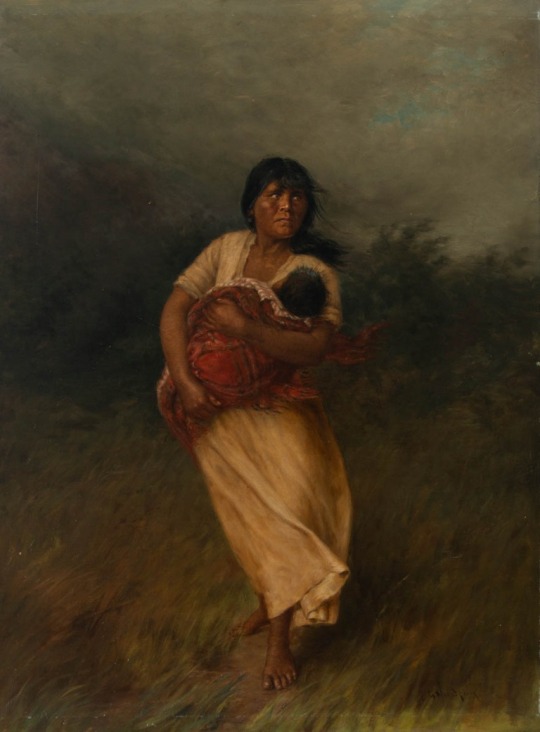
Grace Hudson (1865-1937)
"Back to Her Tribe" (1898)
Oil on canvas
Located in the Crocker Art Museum, Sacramento, California, United States
This painting depicts Joseppa Dick (1865–1905), a well-known Pomo basket weaver. Joseppa and her husband had one son, Billy Peters. In 1898, the year Hudson painted this work, Billy—then almost a teenager—was forcibly taken to the Chemawa Indian School in Oregon. Hudson and her husband, friends of Joseppa, tried to intervene on her behalf but were unsuccessful. While at the school, Billy contracted tuberculosis. He died in California in 1901. Joseppa died four years later.
#paintings#art#artwork#genre painting#female portrait#grace hudson#oil on canvas#fine art#crocker art museum#museum#art gallery#american artist#woman artist#women artists#female artists#portrait of a woman#history#native american#indigenous#violence#death of a child#ethnic cleansing#despair#anguish#mother and child#indian boarding schools#1890s#late 1800s#late 19th century
108 notes
·
View notes
Text
I got a copy of Erdoes and Ortiz's American Indian Myths and Legends (1984) for Christmas and it is fascinating to me how various Native American tales portray romance between humans and non-humans. Especially compared to the European takes on that motif, which usually center on the relationship being doomed from the start, because humans belong only with humans. But this does not seem to be the default in the Native American tales in this collection!
There was one story which did portray the relationship as doomed (Tolowim woman and butterfly man, Maidu) and one where a human woman was taken against her will and gladly rescued by her husband (The stolen wife, Tewa). But there is also a tale where a wife is willingly taken by a great buffalo and when her human husband steals her back and kills White Buffalo Chief, she mourns him so that her jealous husband kills her (Apache chief punishes his wife, Tiwa).
That last tale, while tragic, already goes out of its way to show that the woman was happy with the powerful buffalo, and there are four stories in the collection that make a point of ending in happiness:
The industrious daughter who wouldn't marry (Cochiti)
A beautiful young woman who is a master at making beautiful garments spurns all her human suitors, until it is widely known that she doesn't care for young men. Coyote hears of this and goes to court her, dressed in his finest clothes. He does not offer her any gifts, but he dances very well and he brings a branch of blackcurrants, which are her favourite. She is pleased with him, so she takes him home, sleeps with him, and gives birth to two little coyotes. Her parents are dismayed and the other people turn away from her, but Coyote brings her to his home under the ground. There he has all kinds of clothes just as fine as the ones she makes, and she lives there happily with him ever after.
The Serpent of the Sea (Zuni)
The beautiful daughter of the priest-chief of the village Home of the Eagles cannot abide dust or dirt. Every day she spends almost all her time bathing in the sacred spring of the Serpent of the Sea and this angers him. He changes himself into a beautiful baby boy and she finds him and takes him home to care for him. As soon as she falls asleep the Serpent takes his true form again, coiling himself all around the maiden and all around the room. In the morning the whole household panics, but the girl’s father understands what happened and begs the Serpent to let his daughter return to her family once more, even though she now belongs to him. The Serpent moves enough to release her, finally waking her. She is very frightened, but after four days of ceremonies she bids her family goodbye and goes with the Serpent. As they travel the Serpent takes the shape of a beautiful young man, and speaks in a kinder and kinder voice, until she dares to look at him. Startled she asks him where the terrifying creature has gone. He explains that he is the serpent, but that he loves her, and that if she will consent to come and stay with him they will live and love each other forever in the Waters of the World. The maiden goes with him, forgetting her sadness and forgetting her family, and lived with him ever after.
The man who married the moon (Isleta Pueblo)
The great leader, weaver, and medicine man Nah-chu-rú-chu (the bluish light of dawn) got tired of all the young women trying to win his affection. He proclaimed that he would marry the girl who could grind corn meal so fine that it would stick to his pearl water dipper. The only woman who could do it was the Moon, who was an Isleta maiden before she went to live into the sky. He marries her and loves his moon-wife above all things. Two sisters, the Yellow Corn Maiden, are so jealous that they persuade the moon to admire her reflection in the water of the well, and push her in to drown her. The chief mourns so deeply that it no longer rains and all the crops begin dying, until they bring him a mysterious flower from a mound in the forest where his wife disappeared. He performs a sacred ritual and the moon is brought back to life. The corn maidens are changed into helpful, gentle snakes as punishment, and the moon lives happily with her husband.
The woman who married a merman (Coos)
A girl who refuses all her suitors and goes swimming in the creek every day becomes pregnant without understanding how. She gives birth to a baby that always cries unless it is left outside, where someone brings it seal meat to eat. The young mother watches over her baby and at night is approached by a man who says he is her husband and promises she will be safe if she goes with him. The merman takes his wife and child to the bottom of the sea, where many people lived. Her husband was one of the five sons of the village chief and the couple lived there happy and satisfied. She goes to her relatives once to get arrows for her little boy to play with, and once to visit her brothers. The second time they see her shoulders are turning dark and scaly like those of a sea serpent. She never returned again, but sea serpents came into their harbour, and every summer and winter they would send a whale ashore, a gift to their kinsmen above the sea.
Erdoes and Ortiz even draw a parallel between the tale of the Serpent of the Sea and Beauty and the Beast, but I rather love the girl running off with the Coyote and "the woman who married a merman" is such a lovely counterpoint to the selkie and mermaid stories I grew up with. I'm really happy with this book~
#I'm sure I'm missing lots of nuance and details in my synopsis#but this book is pleasant to read and the tales were clearly written with care#so I really recommend going to read these for yourself if they sound like your thing#American Indian Myths and Legends#native american folklore#laura babbles
54 notes
·
View notes
Text
Meet my OC Spider-Weaver (Spider-Woman, Earth 50513)
For the next few paras I’m gonna rant abt my spidersona :D this might not make any sense at all bc I’m just rambling at this point but here we go anyway! (a small warning, this is going to be a LONG post)
All images are from Pinterest!
TW: Mentions of death, some queerphobia/homophobia (judgemental aunties suck)
Name: Nikita Raina (pronounced Rhi-na like rhino but with an ‘a’ at the end instead of an ‘o’) (yes she’s South-Indian and yes this is me projecting)
Alias: Spider-Weaver*
Basic stuff to know:
-She’s loosely based off of a golden silk orb-weaver spider! I’m not going to attach an image but if you don’t mind staring at spiders then I suggest you look them up, they’re actually really pretty!!
-She’s been learning ballet since she was 3, picked up gymnastics for 2 or 3 years and then quit
-South-Indian
-Complete empath
-INCREDIBLE at knitting/crocheting/macramé knotting - basically anything involving thread + working with your hands. She literally works magic with yarn. She crocheted matching gloves for all of the Spiderteens one day after finding out that Hobie’s universe is COLD and his fingers are COLD and if she’s going to be holding his hand when it’s like that then she’ll freeze
Fighting Style:
Her fighting style is more aerobic and dynamic than the regular Spider-Man swings; she incorporates jetés and leaps from ballet into it while also using mid-air somersaults and other high-speed flips she picked up from gymnastics. She also teaches herself kalari adimurai (a South-Indian martial art similar to kalaripayittu) later on so she uses a few moves from that as well.
*The reason behind her alias being Spider-Weaver is that her web style has more of a lacy crochet feel to it than a regular spiderweb. This is what one of her webs would look like:

Her webs are bionic and on her web shooters she has built-in settings for the thickness and stretchiness of the crochet web. For example:

She can also switch up the style of her webs depending on how she feels yk? Like if she’s not vibing with any of the more plain ones she can switch to ✨ fancier ✨ stitches like
Arcade Stitch:

Lacy Stitches:

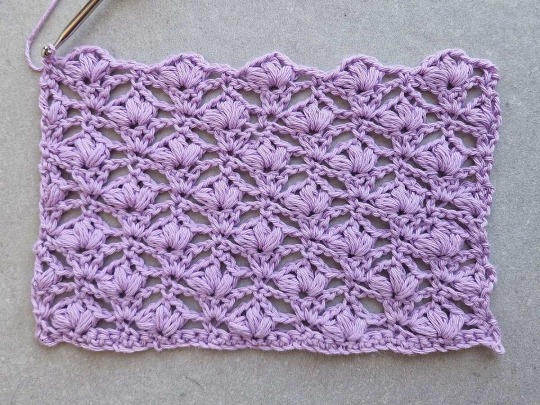
Fan Trellis Stitch:
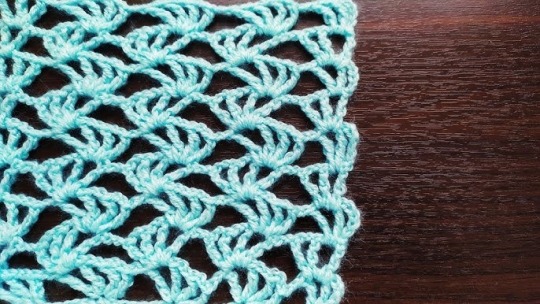
And lots more. She’s basically got almost all crochet stitches as different settings on her web shooters. An added bonus is that they’re not only unique and quite pretty, but they’re also stronger and more durable than the average single-thread (unwoven) webs.
Backstory:
(canon events will be in red)
-She was bitten at 13. Her older brother (he’s 20, they have a 7 year gap) Ravi figured out something was wrong fairly early but she played it off as nothing, put his worries to rest and found her way as Spider-Woman on her own
-She was best friends with her universe’s Gwen Stacy since they were in kindergarten. She started freaking out few years into their friendship (they’re in middle school now) once they had become basically inseparable because she started feeling giddy and bubbly and getting butterflies around Gwen.
-Poor girl was basically terrified because her aunties (mostly her mother’s sisters) would constantly pressurise her by asking her if she had her sights set on a boy yet or discussing how her marriage to a boy would go once she was older - those prodding conversations and speculations only reinforced her fears that she wouldn’t be accepted and instead would be frowned upon if she told her family that she had a crush on a girl. So she became more withdrawn and distanced herself a little, so as to not to lose the favour of her family.
-Nikita is 14 at this point
-One day she accidentally told Ravi and she went quiet, expecting him to shame her or mock her but instead he just hugged her and told her he loved her no matter what, and guess what,, he’s queer (pan) too :D
-Fast forward to a few weeks later after an almost-death scare as Spider-Woman fighting her dimension’s Vulture (she slipped up, miscalculated a leap and almost got herself killed) she finally worked up the courage to tell Gwen because it seems like she returns her feelings too! So she goes up to her and they hug and they’re talking and she’s about to confess- But noooo
-Green Goblin attacks in the middle of the school day, during a student art & drama exhibition thing (the parents are all there) and hahaha guess what Gwen’s right in the middle of it
-So Green Goblin basically splits the school building in two and she’s on the terrace and she falls down almost 15 feet because the whole thing’s cracked and Nikita doesn’t have enough time to swing to reach her since there are so many people and she’s on the far, far side and-
-Gwen hits the ground at full force. Niki gets there just in time for her last breath and it’s a little bit like the Gwen-Peter 65 scene from ATSV (Niki’s Gwen slowly figured out that she’s Spider-Woman, she just didn’t say anything) yeah I might write out this scene sometime idk
-She manages to deal with Green Goblin for the moment but she loses her dad in the chaos too (basically instead of losing her uncle she lost her dad)
-So she lost her best friend and her father in one go
-She closes herself off and withdraws completely into herself and distances herself from everybody (except Ravi),, & starts going to ballet more to take her mind off things and to get lost in ballet, with the graceful, controlled movements so she doesn’t have to think of how everything’s gone wrong
-During the mourning period she and Ravi grow closer; they both start leaning more on each other and are able to tell each other anything
-Ravi has also started training to be a cop at this point
-Her relationship with her mother grows slightly strained and shaky the older she gets, because of how closed off she’s become
-Fast forward to when Nikita is 16 and a half and the Vulture attacks particularly viciously one day, right on the bridge (the Brooklyn Bridge variant in her universe)
-Her brother (who is now a police captain, despite being a little young) is in the middle of the maelstrom of cars being flung and buildings at the end collapsing. He - a police captain close to Spider-Woman - dies saving a child from falling rubble.
-That does a number on Nikita mentally and she just. Shuts herself down in terms of feeling emotion for a bit
-Like she just goes numb, like she’s in denial about how many people she’s lost in such a short time
-Terrified to make friends or get attached because her losing someone she cares about deeply seems to be a recurring pattern
-The only one she has left is her mom, and she’s grown really distant from her
-Little bit irrelevant but she takes up psychology. She studies how the emotional part of brain works, studies some basic therapy and other think-y stuff like that, and some of her Spider-Woman ‘jabs’ (not really but I can’t think of a word for them rn) are things like “did something formative happen to you as a child? yeah I thought I sensed some childhood trauma, would you like to talk about it?” And stuff like that (she’s pretty genuine about it too, if they start talking instead of just attacking her then she will sit down with a mug of chai and just listen to them rant)
-Anyway fast forward to a year and a half later when she’s 18
-Jessica Drew ends up following an anomaly she’s been tracking into Nikita’s dimension, the anomaly manages to get the upper hand on her and has almost overpowered her when Nikita finally swings in (probably during/right after a psychology exam too) and uses the element of surprise + her speed to get the upper hand on the anomaly and web it up
-She was recruited into the Spider-Society by Jess after she saw how capable and quick-thinking Niki could be. She saw her as someone who could be a useful asset to the society.
-It’s there where she met Hobie, Gwen, Pavitr, Margo, Miguel and Peter B. + a few other spiders she became friends with (I’ll expand on their relationships in a different post)
Suit design:
(I will be drawing this out properly sometime soon, don’t worry!! Feel free to skip this part if you think it’s too complicated ^^ I really have no idea how to describe it in a simpler way lmao)
-mainly shades of gold, black highlights
-on her arms there are black “cuff” markings like a golden silk spider’s legs
-on her wrists she has black bangles (more like cuffs bc they fit around her wrists, they aren’t loose & dangly)
-wears black fingerless sleeves, they look a little bit like Gwen’s but they have black splotches (a little bit like spray paint blobs) instead of spiderwebs
-has a black spider on the front of the suit
-wears a necklace! it’s colourful and has some mismatched colourful beads on a chord and two pendants in the centre, one pendant is a paint-splashed red electric guitar, the other pendant is one of Hobie’s rings
-wears black ballet pointe shoes
-the eye outline is black, the ‘eye’ inside is pastel golden
-black 🕸️ patterns on the side of both of her shoulders (like painted pauldrons)
Abilities:
-Along with the super-strength, super-speed and accelerated healing of the average Spider-Person, she can sense emotions and thoughts.
Not mind-reading exactly but if she focuses hard enough she can sense whatever emotion is radiating out of that particular person’s mind (she used to get very overwhelmed in middle school bc of the sheer amount of envy and insecurity and other emotions in raging hormonal teenagers’ brains and somehow studying psychology helped her figure out how to tune it out a little bit, since every time she can sense too much of intense emotions it’s like constantly blowing a dog whistle around a dog,, and she also gets horrible migraines and headaches from it)
She can even read thoughts if the emotion associated with it is strong enough.
An added ability that stems from being able to sense emotions and thoughts (to some degree) is that she can sometimes predict the moves that an enemy might make before they actually make them. It’s not 100% accurate every time but it’s still pretty useful
I’ll write out her relationships (everyone already knows that Hobie’s no. 1 on that list lmao) and the world descriptions later, but for now here’s the character that’s been living in my head since I saw ATSV :D
Oh also she’s besties with @hobiebrownismygod ’s sona Maitreyi :D desis gotta stick together yk (putting this here so I don’t forget to mention it in the relationships post ^^)
#⋆·˚ 🕷️🌟 ༘ * — 𝙨𝙥𝙞𝙙𝙚𝙧-𝙬𝙚𝙖𝙫𝙚𝙧!#it’s 1am#and i have to be up by 6 tmrw#whoopsies#not proofread at all btw#atsv#across the spiderverse#spidersona#spiderman oc#atsv oc#atsv original character#spider oc#oc x canon#hobie brown x oc#<- implied#nikita raina
36 notes
·
View notes
Note
Feel free to point me to google, but I was wondering if you could elaborate on mughal rulers not colonizing India? For context I’m a Nri moved to USA when I was very young so I’m very divorced from Indian history outside of accepted propaganda narratives from family, that I am unlearning.
the point is that the mughals did in fact invade and conquer a huge chunk of the indian subcontinent (the farthest south they ever got to was the deccan) but they did not colonise india. however, they did not colonise india. that would be the british
also the mughals more or less assimilated into south asia. however the british had a very different relationship with south asians (which was literally racism. they also heavily exploited the lower castes, artisans and weavers. and ofc, how can i forget the bengal famine. or churchill's racism)
21 notes
·
View notes
Text
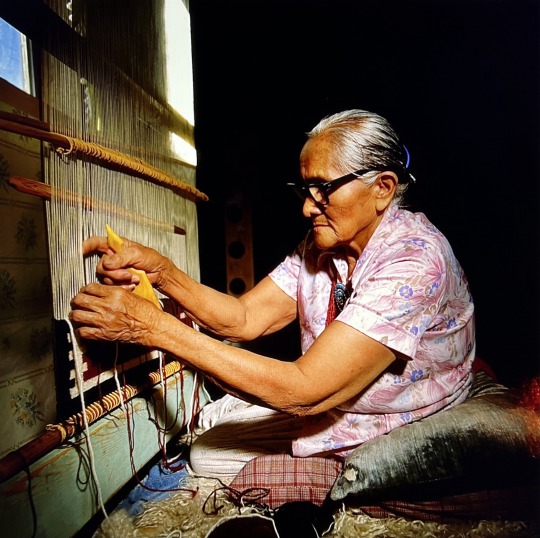
Grace Henderson Nez, Navajo rug weaver, Ganado Arizona, RA Clayton #indian #navajorugweaver #navajoindian #portrait
37 notes
·
View notes
Text

Peridean Aliens: Concept Designs (original characters)
More info under the cut - if ya wanna read.
So before we see this new galaxy in Ahsoka I made some OC’s/concept designs of the Aliens who dwell there.
Mahin (Red) - aged 28; a priestess and tapestry weaver known for her silver tongue & calming presence that may not be wholly natural as she uses the force in peculiar ways compared to the Star Wars Galaxy. She finds the extended visitors to her galaxy fascinating, especially the young force wielder among them whose relationship with the force is both familiar and completely alien to their ways.
Parvana (Blue) - aged 16; Ezra found her when she was 11 and trained her in the ways of the force he knew whilst they both learned from figures like Mahin on how the Perdiea Galaxy channels the force. Her lightsaber pike does not utilise a Kyber crystal, instead utilising a crystal that give the lightsaber a cold blade; the blade generates an endothermic effect turning whatever it cuts frozen & brittle instantly, the energy absorbed creates a devastating impact force that shatters rather than cuts. She has a fiercely ferocious fighting style that reflects this and is often difficult for Ezra to temper once lost in a battle frenzy.
Based on the idea that these are the ancient ancestral race of the Dathomirian night-sisters & -brothers, largely untainted by human genetics, both the males and females have horns -though not pictured here- the males have sets of 4 horns that have different shapes and patterns based on region & or subspecies. The facial markings are a mix of natural markings that are then emphasised or added to with tattoos. The veils/ head coverings are worn by both genders under moonlight, due to heavy cultural worship of their lunar celestial bodies.
Culturally they are a reserved people who have deeply somber and reflective temperament, especially during religious events, but are also deeply family oriented and food culture is a huge part of that expression of unity.
The culture inspirations lay primarily in Persian & Indian influences with a touch of East Asian to help tie into the Star Wars aesthetic. The animalistic anatomy was based on goats as I wanted them to be from mountainous biomes, so the goat feet seemed interesting and the horns could have many different variations based on gender & subspecies.
#star wars#star wars aliens#star wars original character#star wars fanart#star wars rebels#OC: Mahin#OC: Parvana#star wars ahsoka#ahsoka spoilers#ahsoka speculation#had a brain worm and just wanted to draw stuff#Pathway to Peridea#New Star Wars Galaxy#star wars art
19 notes
·
View notes
Text
Handloom clothes and products have been a part of India's cultural heritage for centuries. With the increasing demand for sustainable and eco-friendly fashion, handloom products have gained popularity both in India and abroad. Handloom clothes are made using traditional techniques, resulting in unique designs and textures. The handloom industry also provides employment opportunities to millions of people across India, contributing to the country's economy. By supporting the handloom industry, consumers can not only get access to high-quality and sustainable products but also play a role in preserving India's cultural heritage.
#handloom clothes#handloom products#handloom weavers in india#indian handloom#handloom manufacturers in India
1 note
·
View note
Text
The evaluation of Mayo's work [Mother India] and its impact has been left to such scholars as the authors of Marriage: East and West, who write:
The dust finally settled. It was conceded that Katherine Mayo's facts, as facts, were substantially accurate. It was recognized that she had taken up a serious issue and drawn attention to it, which had helped in some measure to hasten much-needed reforms. But at the same time her book had done a grave injustice to India, in presenting a one-sided and distorted picture of an aspect of Indian life that could only be properly understood within the context of the entire culture [emphases mine].
Thus Mayo is put in her place. We find here the familiar use of the passive voice, which leaves unstated just who conceded, who recognized. We find also the familiar balancing act of scholars, which gives a show of "justice" to their treatment of the attacked author. The qualifying expression, "as facts," added to "facts," has the effect of managing to minimize the factual. Women who counter the patriarchal reality are often accused of "merely imagining," or being on the level of "mere polemic." Here we have "mere" facts. Then the authors graciously concede that Mayo hastened "much-needed reforms," which gives the impression that everything has now been taken care of, that the messy details have been tidied up. Then comes the peculiarly deceptive and unjust expression "grave injustice to India." Mayo was concerned about grave injustice to living beings, women. Injustice is done to individual living beings. One must ask how it is possible to do injustice to a social construct, for example, India, by exposing its atrocities. We might ask such re-searchers whether they would be inclined to accuse critics of the Nazi death camps of "injustice" to Germany, or whether they would describe writers exposing the history of slavery and racism in America as guilty of "injustice" to the United States. The Maces go on to accuse Mayo of distorting "an aspect of Indian life." But what is "Indian life"? Mayo is concerned not with defending this vague abstraction (presumably meaning customs, beliefs, social arrangements, et cetera), but with the lives of millions of women who happened to live in that part of patriarchy called "India."
The final absurdity in this scholarly obituary is the expression "properly understood within the context of the entire culture." It is Katherine Mayo who demonstrates an understanding of the cultural context, that is, the entire culture, refusing to reduce women to "an aspect." Her critics, twenty years after her death, attempted to absorb the realities she exposed into a "broad vision," which turns out to be a meaningless abstraction.
Feminist Searchers should be aware of this device, commonly repeated in the re-searchers' rituals. It involves intimidation by accusations of "one-sidedness," so that others will not listen to the discredited Searcher-Scholar who refused to follow the "right" rites. The device relies upon fears of criticizing "another culture," so that the feminist is open to accusations of imperialism, nationalism, racism, capitalism, or any other "-ism" that can pose as broader and more important than gynocidal patriarchy. Thus the just accuser becomes unjustly sentenced to erasure. Her life's meaning, as expressed in her life's work, is belittled, reversed, wiped out.
Feminist Seekers/Spinsters should search out and claim such sisters as Katherine Mayo. Her books are already rare and difficult to find. It is important that they do not become extinct. Spinsters must unsnarl phallocratic "scholarship" and also find our sister weavers/dis-coverers whose work is being maligned, belittled, erased, deliberately forgotten. We must learn to name our true sisters, and to save their work so that it may be continued rather than re-covered, re-searched, and re-done on the endless wheel of re-acting to the Atrocious Lie which is phallocracy. In this dis-covering and spinning we expand the dimensions of feminist time/space.
-Mary Daly, Gyn/Ecology
#mary daly#Katherine mayo#patriarchal scholarship#radical feminist analysis#female oppression#patriarchy#suttee
9 notes
·
View notes
Text
All Identity V references (or easter eggs) to popular culture found.
Some are taken from theories of fandom others are found by me.
Martha Remington as the surname taken from the typewriter brand "remington" (also curious beacause in the game you have to decode typewriters)
Doctor, Emily Dyer is inspired by Amelia Dyer a british serial killer who killed lots of young children while beyond her cares.
Helena Adams references to Helen keller, a blind def woman who were a full-time activist.
Priestress (Fiona Gilman) references to HP Lovecraft's story "The dream in the witch's house."
The Magician references to Servais le roy, the creator of the illusion technic of levitation.
Naib Subedar, in his backstory makes reference to the british invasion of india.
Thief, Kreacher Pierson references George Müller, a Christian evangelist and the director of the Ashley Down orphanage in Bristol, England. He was one of the founders of the Plymouth Brethren movement. His surname is named after Arthur Tappan Pierson, a friend of George Müller who wrote his biography.
The explorer references to Gulliver's Travels.
William Ellis references William Webb Ellis, the alleged inventor of rugby. He also shares the exact same name as him
Norton Campbell's background story references the author H.P Lovecraft's short story titled The Transition of Juan Romero.
Enchantress, Patricia Dorval's adoptive mother references Marie Laveau a Louisiana Creole practitioner of Vodou, herbalist and midwife who was renowned in New Orleans.
Wilding, Murro's Deductions mentions Kasper Hauser, a German youth who claimed to have grown up in the total isolation of a darkened cell.
Female Dancer, Margaretha Zelle references both Mata Hari, a Dutch exotic dancer and courtesan who was convicted of being a spy for Germany during World War I and Natalia from The Last Circus.
Acrobat, Mike Morton's appearance references both Arlecchino from Commedia dell'arte and Vander Clyde Broadway an American female impersonator, high-wire performer, and trapeze artist born in Texas.
"Prisoner", Luca Balsa references Nikola Tesla a Serbian-American inventor, electrical engineer, mechanical engineer, and futurist best known for his contributions to the design of the modern alternating current (AC) electricity supply system.
Entomologist, Melly Plinius references Pliny the Elder (Gaius Plinius Secundus) the Roman author/naturalist/natural philosopher.
Batter, Ganji Gupta's background story references the British Colonization of Indian Subcontinent (1858-1947).
"Psychologist", Ada Mesmer's Surname references Franz Anton Mesmer, a German physician who developed the theory of animal magnetism. She may also be inspired in Ada Lovelace the matematician
Soul Weaver, Violetta references Aloisia 'Violetta' Wagner, a famous German freak show performer from the early 20th century. She was renowned for having tetra-amelia syndrome.
The Ripper, Jack references Jack the Ripper an unidentified serial killer active in the impoverished districts in and around Whitechapel in the East End of London in 1888. His background story references Walter Sickert, a German-born British painter and print maker who was a member of the Camden Town Group of Post-Impressionist artists in early 20th-century London and was suspected of being Jack the Ripper.
Geisha, Michiko references Chōchō-San from Madame Butterfly. She may also reference Yosano Akiko or Higuchi Ichiyo, both famous writers and geishas. But not only, she may reference the play of Fukuchi Ochi "Mirror Lion" .
Hastur is based on The King in Yellow from H.P. Lovecraft novels (Cthulhu Mythos Franchise).
Wu Chang, Xie Bi'an and Fan Wujiu references Heibai Wuchang (黑白无常, Black and White Impermanence) the two Deities in Chinese folk religion in charge of escorting the spirits of the dead to the underworld.
Photographer, Joseph Desaulniers references both Nicéphore Niépce a French inventor, usually credited as the inventor of photography and a pioneer in that field and Dorian Gray from The Picture of Dorian Gray. His background story also mentions the French Revolution.
Mad Eyes, Burke Lapadura references Edmund Burke, a highly regarded Canadian architect best known for building Toronto's Prince Edward Viaduct or "Bloor Street Viaduct" and Toronto's Robert Simpson store.
Dream Witch, Yidhra references Yidhra from the H.P. Lovecraft novels (Cthulhu Mythos Franchise).
Bloody Queen, Mary references both Marie Antoinette the last queen of France and a controversal figure during the French Revolution and the abilities based on Bloody Mary.
"Disciple", Ann's background story references the Salem witch trials.
Violinist, Antonio references Niccolò Paganini an Italian violinist and composer. He was the most celebrated violin virtuoso of his time, and left his mark as one of the pillars of modern violin technique.
Sculptor, Galatea Claude possibly references Camille Claudel a French sculptor known for her figurative works in bronze and marble and her name references to the statue carved of ivory by Pygmalion of Cyprus of the same name from Greek Mythology.
"Undead", Percy references Victor Frankenstein from the author Mary Shelley's novel Frankenstein.
The Breaking Wheel, Will Brothers references the Breaking wheel with their trailer also referencing the Execution of St Catherine.
Naiad, Grace references Naiads, fresh water nymphs presiding over fountains, wells, springs, streams, brooks and other bodies of fresh water from Greek Mythology. She also appears to reference H.P. Lovecraft's novella The Shadow Over Innsmouth.
Wax Artist, Philippe is based on Philippe Curtius a Swiss physician and wax modeller who taught Marie Tussaud the art of wax modelling.
Hermit, Alva Lorenz references Thomas Edison, a famous inventor.
Night Watch, Ithaqua is based on Ithaqua from H.P. Lovecraft novels (Cthulhu Mythos Franchise).
"Big Daddy" is likely a reference to "Big Brother" from 1984 by George Orwell, the leader who keeps all citizens under constant surveillance and controls them.
Allen, while little is currently known about him, is likely based off Zadok Allen from The Shadow Over Innsmouth.
Andrea may be based on Antonia Bianchi, a singer and the long term lover of Niccolo Paganini.
Arthur Byers is likely based on Ambrose Bierce, the author of “Haïta the Shepherd” in which Hastur first appeared.[1]
Catherine is based on St. Catherine of Alexandria who was executed using a breaking wheel.
Christina's death scene in Philipe's character trailer is an allusion to The Death of Marat by French painter Jacques-Louis David.
Claude Desaulniers is based on Claude Niépce, the older brother of French inventor Nicéphore Niépce.
Damballa is based on the benevolent spiritual intermediary in Haitian Voodoo of the same name.
James Reichenbach's last name is a reference to Reichenbach Falls, the name of the location where Arthur Conan Doyle's character Sherlock Holmes had his fight to the death with his greatest foe Professor Moriarty.
James Whistler is based on the real life painter James Abbott McNeill Whistler who was the mentor of Walter Sickert.
Papa Legba is based on trickster spiritual intermediary in Haitian Vodou of the same name.
Princess Lamballe is based on Marie Thérèse Louise of Savoy (Princesse de Lamballe) who was one of Marie Antoinette's closest friends.
Robert is likely based off Robert Olmstead, the main character and narrator of The Shadow Over Innsmouth.
Sullivan is based on Anne Sullivan Macy, an American teacher and lifelong friend of Helen Keller.
The currently Unnamed Cat God is likely based on the short stories Nyarlathotep and Cats of Ulthar by H.P. Lovecraft.
Blue Aladdin references to Aladdin from Aladdin and the Wonderful Lamp.
Violet Peacock's Chinese description references to The Peacocks Fly Southeast.
Both Poseidon's Crown and Poseidon references to Poseidon the god of the sea, storms, earthquakes and horses from Greek Mythology.
Caged Butterfly's description mentions Madame Butterfly.
The 1st Essence of Season 2 is based on several Fairy Tale Stories on each Costumes.
King's Tailor references to one of the Swindler from The Emperor's New Clothes.
Both Lazy Mr. Bunny and Mr. Turtle references to The Hare and The Tortoise from The Tortoise and the Hare.
King Arthur references to the character of the same name
Merlin references to the character of the same name.
Black Swan is based on Odile (The Black Swan) from Swan Lake.
Anubis is based on the god of the same name who is the god of death, mummification, embalming, the afterlife, cemeteries, tombs, and the Underworld in Egyptian Mythology.
Ancient Soul references to the Ankh an ancient Egyptian hieroglyphic symbol used in Egyptian art and writing to represent the word for "life" and, by extension, as a symbol of life itself.
Soul Catcher references to Day of the Dead a holiday traditionally celebrated on November 1 and 2, though other days, such as October 31 or November 6 from Mexica.
Golden Touch is based on King Midas a king of Phrygia who is known to turn everything he touched into gold from Greek Mythology.
The 1st Essence of Season 6 has several references to Greek Mythology.
Icarus is named after and based on the hero of the same name who is the son of the master craftsman Daedalus, the creator of the Labyrinth on Greek Mythology.
Apollo is named after and based on the God of the same name who is the god of oracles, healing, archery, music and arts, sunlight, knowledge, herds and flocks, protection of the young and the Member of Twelve Olympians.
Leonidas is named after Leonidas I a king of the Greek city-state of Sparta.
Pam possibly is based on Pan the god of the wild, shepherds and flocks, rustic music and impromptus, and companion of the nymphs.
Captain Hook is based on Captain James Hook.
Eversleeping Girl is based on Wendy Darling.
Forgotten Boy is possibly based on Peter Pan or one of the Lost Boys.
Siren is possibly based on the Mermaids from Mermaids' Lagoon.
March Hare is based on the Character of the Same Name.
Alice is based on the Protagonist of the Same Name.
Mr. Bunny is based on The White Rabbit.
Bill is based on Bill The Lizard.
Caterpillar is based on Hookah-Smoking Caterpillar.
Knave of Hearts is based on the character of the same name.
Executioner is based on one of the Queen of Hearts' Card Soldiers.
The Mad Hatter is based on the character of the same name.
Queen of Hearts is based on the character of the same name.
Serpent is based on Quetzalcoatl the god of life, light and wisdom, lord of the day and the winds from Aztec Mythology.
Lady Thirteen is based on Yu Mo from The Flowers of War, portrayed by the actress Ni Ni.
Sophia is based on Sophia Palaiologina a Byzantine princess, member of the Imperial Palaiologos family, Grand Princess of Moscow as the second wife of Grand Prince Ivan III.
Ivan is possibly based on Ivan III of Russia a Grand Prince of Moscow and Grand Prince of all Rus'.
Maroon Crystal is based on Dorothy Gale.
Princess Ozma is based on the character of the same name.
The Wicked Witch is based on both Wicked Witch of the West and Dorothy Gale.
Emerald City Coachman is based on the Coachman.
Oz, the Wizard is based on Wizard of Oz.
The Tin Man is based on Tin Woodman.
The Spookcrow is based on Scarecrow.
The Toothless Lion is based on Cowardly Lion.
Golden Ratio references to the Philosopher's Stone a mythic alchemical substance capable of turning base metals such as mercury into gold.
Electrolysis references to the technique of the same name that uses direct electric current (DC) to drive an otherwise non-spontaneous chemical reaction.
Ouroboros references to the ancient symbol of the same name that depicts a snake or dragon eating it's own tail.
Choir Boy has a The squared circle symbol an alchemical symbol (17th century) illustrating the interplay of the four elements of matter symbolising the philosopher's stone on his back.
Mutation represents Chrysopoeia an artificial production of gold, most commonly by the alleged transmutation of base metals such as lead.
Sulfuric Acid has a tattoo on chest resembling the symbol of the same name based on Dalton's Law of Atomic Weights.
Vine references to the Elixir of life a potion that supposedly grants the drinker eternal life and/or eternal youth.
Philofelist possibly references to Necromancy a practice of magic or black magic involving communication with the dead – either by summoning their spirits as apparitions, visions or raising them bodily – for the purpose of divination, imparting the means to foretell future events, discover hidden knowledge, to bring someone back from the dead, or to use the dead as a weapon.
Judge represents Pride.
Deputy represents Greed.
Clerk represents Envy.
Court 3 Commissioner represents Wrath.
Court 5 Commissioner represents Sloth.
Court 6 Commissioner represents Gluttony.
Court 7 Commissioner represents Lust.
Narcissus is named after the character of the same name who rejected all romantic advances, eventually falling in love with his own reflection in a pool of water, staring at it for the remainder of his life, his name is the origin of Narcissism.
Clio is named after the goddess of the same name who is the goddess of history, lyre playing and a member of the Muses.
Talia is named after Thalia who is the goddess of comedy and a member of the Muses.
Hebe is named after the goddess of the same name who is the goddess of eternal youth, prime of life, forgiveness
"Succubus" is named after a demon of the same name they are female demons that appears in dreams to seduce men, usually through sexual activity.
Rainmaker's Beauty Form is based on both Lady Shizuka, one of the most famous women in Japanese history and literature and Ameonna, a yōkai thought to call forth rain while the Prajna Form is based on Kuchisake-onna, that appears as a malicious spirit, or onryō, of a woman, that partially covers her face with a mask or other item and carries some sort of sharp object.
"The Prince" is based on the titular character of the The Happy Prince.
Feathered Cloak is based on Freyja, a goddess associated with love, beauty, fertility, sex, war, gold, and seiðr (magic for seeing and influencing the future) from Norse Mythology.
The 3rd Essence of Season 17 is based on The Masque of the Red Death.
Man in Red is based on The Red Death.
Runaway is based on Prince Prospero.
The 1st Essence of Season 18 is based on The Marriage of Figaro.
Fury is based on both Count Almaviva (Philippe) and Countess Rosina (Christina).
"Susanna" is based on the character of the same name.
The 1st Essence of Season 20 is based on And Then There Were None.
The 2nd Essence of Season 20 takes place on The Crystal Palace on a fictional setting.
Lockheart is shown to be a fictional daughter of the in real life historical figure Joseph Paxton an English gardener, architect, engineer and Member of Parliament, best known for designing the Crystal Palace.
The 1st Essence of Season 21 is based on Bacchanalia, an unofficial, privately funded popular Roman festivals of Bacchus, based on various ecstatic elements of the Greek Dionysia.
Spring Heated Wine is based on Dionysus, the god of the grape-harvest, wine making, orchards and fruit, vegetation, fertility, insanity, ritual madness, religious ecstasy, festivity, and theatre and a Member of the Twelve Olympians from Greek Mythology.
Bai Ze is based on Bai Ze itself, a mystical Chinese beast connected with spirits.
The 3rd Essence of Season 22 is based on insects and also the seven virtues.
Winter Cicada represents Humility.
Frozen Butterfly represents Chastity.
Ant represents Charity.
Scorpion represents Kindness.
Mayfly represents Diligence.
Centipede represents Temperance.
Worker Bee represents Patience.
Boudoir Dream is based on Child Jane Hudson from What Ever Happened to Baby Jane which is a film adaptation of a novel of the same name, portrayed by the child actress Julie Allred
Iron Lady is based on Harriet Craig from the film of the same name which is a film adaptation of Craig's Wife, portrayed by the actress Joan Crawford.
Samara is based on Samarra from The Prodigal which is a film adaptation of Parable of the Prodigal Son, portrayed by the actress Lana Turner.
Rhythm of the Rain is based on Kathy Selden from Singin' in the Rain, portrayed by the actress Debbie Reynolds.
Recluse is based on Jef Costello from Le Samouraï, portrayed by the actor and filmmaker Alain Delon.
Hamlet is based on the titular character of the 1948 film which is the film adaptation of the play of the same name, portrayed by the actor and director Laurence Olivier.
Colonel Dax is based on the character of the same name from Paths of Glory which is a film adaptation of the novel of the same name, portrayed by the actor and filmmaker Kirk Douglas.
The Red Shoes is based on Victoria Page from The Red Shoes which is a film adaptation of a fairy tale of the same name, portrayed by the actress ballet dancer and actress Moira Shearer.
The Black Tulip is based on both Guillaume de Saint Preux and Julien de Saint Preux from The Black Tulip which is a film adaptation of the novel of the same name, both portrayed by the actor and filmmaker Alain Delon.
Just Around the Corner is based on Penny Hale from Just Around the Corner which is a film adaptation of Lucky Penny, portrayed by former child actress, singer, dancer, and diplomat and diplomat Shirley Temple.
Zouzou is based on the titular character of the 1934 film, portrayed by actress, French Resistance agent, and Civil Rights Activist Josephine Baker.
Ben-Hur is based on Judah Ben-Hur from Ben-Hur which is a film adaptation of Ben-Hur: A Tale of the Christ, portrayed by the actor and political activist Charlton Heston.
Dorothy is based on Dorothy Gale from The Wizard of Oz which is a film adaptation of The Wonderful Wizard of Oz, portrayed by actress and singer Judy Garland.
Salome is based on the titular character from the movie of the same name, portrayed by actress, dancer, and producer Rita Hayworth.
Da Vinci is based on Leonardo da Vinci from The Life of Leonardo da Vinci which is a miniseries about the real life artist, portrayed by actor Philippe Leroy.
Svengali is based on the titular character of the 1931 film which is a film adaptation of Trilby, portrayed by the actor on radio, stage and radio John Barrymore.
Rashomon is based on the Samurai's wife from Rashomon which is a film adaptation of two Ryūnosuke Akutagawa novels "In a Grove" and "Rashōmon", portrayed by the actress Machiko Kyō.
Broken Blossoms are based on Cheng Huan from Broken Blossoms which is a film adaptation of The C**** and the Child, portrayed by the actor Richard Barthelmess.
Scarlet is based on Scarlett O'Hara from Gone with the Wind which is a film adaptation of the novel of the same name, portrayed by the actress Vivien Leigh.
Faust is based on the titular character of the 1927 film which is a film adaptation of the play of the same name, portrayed by the actor, director and singer Gösta Ekman.
Million Dollar Mermaid is based on Annette Kellerman from the film of the same name which is a biography about the real life swimmer, portrayed by swimmer and actress Esther Williams.
#identity v#idv embalmer#idv#idv shitpost#easter eggs#so many references#idv easter eggs#identityv gameplay#identityv#idv gamekeeper#idv yidhra#idv geisha#idv fanart
28 notes
·
View notes